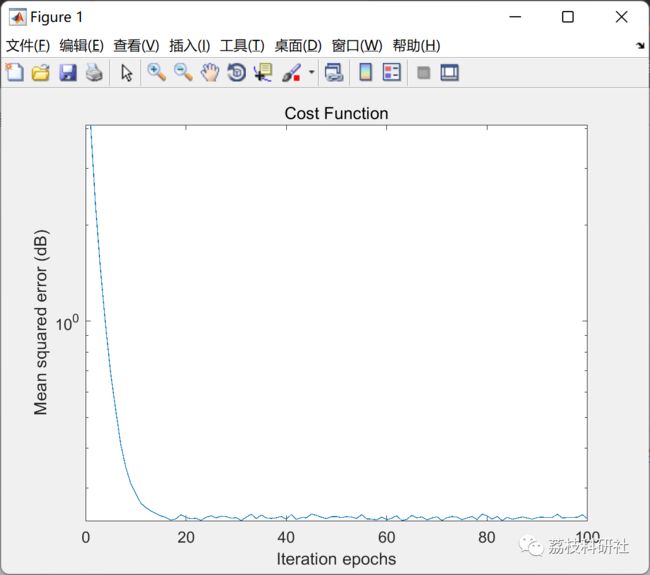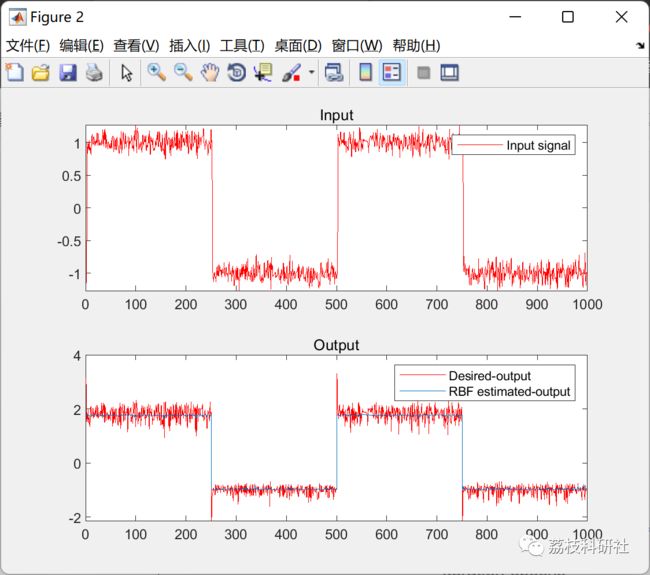基于RBF神经网络的非线性系统识别(Matlab代码实现)
欢迎来到本博客❤️❤️❤️
博主优势:博客内容尽量做到思维缜密,逻辑清晰,为了方便读者。
⛳️座右铭:行百里者,半于九十。
目录
1 概述
2 运行结果
3 参考文献
4 Matlab代码实现
1 概述
在此仿真中,实现了用于非线性系统的零阶近似的RBF-NN。模拟包括蒙特卡罗模拟设置和 RBF NN 代码。对于系统估计,使用具有固定中心和扩散的高斯核。而 RBF-NN 的权重和偏差使用基于梯度下降的自适应学习算法进行优化。
2 运行结果
部分代码:
% Random initialization of the RBF weights/bias
W1 = randn(1,n1);
b = randn();
for k=1:epochs
for i1=1:len
% Calculating the kernel matrix
for i2=1:n1
% Euclidean Distance / Gaussian Kernel
ED(i1,i2)=exp((-(norm(x(i1)-c(i2))^2))/beeta^2);
end
% Output of the RBF
y(i1)=W1*ED(i1,:)'+b;
% Desired output + noise/disturbance of measurement
d(i1)= h(1)*x(i1+2) +h(2)*x(i1+1)+h(3)*x(i1)+h(4)*(cos(h(5)*x(i1+2)) +exp(-abs(x(i1+2))))+sqrt(noise_var)*randn();
% Instantaneous error of estimation
e(i1)=d(i1)-y(i1);
% Gradient Descent-based adaptive learning (Training)
W1=W1+learning_rate*e(i1)*ED(i1,:);
b=b+learning_rate*e(i1);
end
MSE_epoch(k) = mse(e); % Objective Function (to be minimized)
end
MSE_train=MSE_train+MSE_epoch; % accumulating MSE of each epoch
epoch_W1=epoch_W1 + W1; % accumulating weights
epoch_b=epoch_b + b; % accumulating bias
end
MSE_train=MSE_train./runs; % Final training MSE after #runs of independent simulations
W1=epoch_W1./runs; % Final Weights after #runs of independent simulations
b=epoch_b./runs; % Final bias after #runs of independent simulations
semilogy(MSE_train); % MSE learning curve
xlabel('Iteration epochs');
ylabel('Mean squared error (dB)');
title('Cost Function')
Final_MSE_train=10*log10(MSE_train(end)); % Final MSE value
%% Test Phase
% Reset input and output
y=0;
d=0;
x=0;
x=[-1*ones(1,delays) ones(1,round(len/4)) -ones(1,round(len/4)) ones(1,round(len/4)) -ones(1,round(len/4))];
x=awgn(x,20);
for i1=1:len
for i2=1:n1
ED(i1,i2)=exp((-(norm(x(i1)-c(i2))^2))/beeta^2);
end
y(i1)=W1*ED(i1,:)'+b;
d(i1)= h(1)*x(i1+2) +h(2)*x(i1+1)+h(3)*x(i1)+h(4)*(cos(h(5)*x(i1+2)) +exp(-abs(x(i1+2))));
e(i1)=d(i1)-y(i1);
end
MSE_test=10*log10(mse(e)); %%% Objective Function
figure
subplot(2,1,1)
plot(x(1:end-delays),'r')
title('Input');
legend('Input signal')
subplot(2,1,2)
plot(d(1:end-delays),'r')
hold on
plot(y(delays+1:end))
title('Output');
legend('Desired-output','RBF estimated-output')
3 参考文献
[1]Khan, S., Naseem, I., Togneri, R. et al. Circuits Syst Signal Process (2017) 36: 1639. doi:10.1007/s00034-016-0375-7

